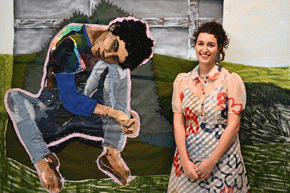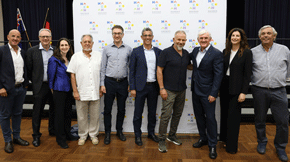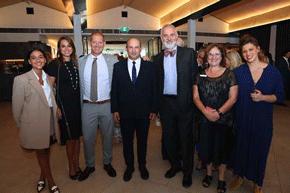Saving a historic building
In the quiet Israeli university town of Rehovot, a name which means “wide expanses” in Hebrew, an historic building with important Australian and Jewish links, is in danger of falling into disrepair.

Slutzkin great-grandson David Stark, Ambassador Chris Cannan, De Shalit High School principal Avi Kish, past principal Revital Bar Yosef, Slutzkin great-great niece Tania Hammer.
Built in 1908 by Lazar Slutzkin, an Australian Jew living in what was then Turkish Palestine, and his wife Rose Blashki, the once-grand mansion is now home to a local high school. An early Australian Zionist and ladies’ wear manufacturer, Lazar built the family a home, with majestic stone archways, tree-shaded porches, and 15 stairs leading up to the entrance, representing the 15 stairs on which the Levites stood in the Temple. The surrounding land was planted with orchards and vegetables.
In 1911, Lazar and Rose with their seven children moved from Melbourne to Rehovot where they stayed until 1915. During the First World War, the family were evacuated to Egypt.
In 1917, following the Australian Light Horse victory at Beersheba, Australian General Harry Chauvel requisitioned the house as
officer headquarters for the rest of the war. It was from here that he planned the Australian part in the 1917 capture of Jerusalem. Chauvel returned the house keys to Lazar when the family came back from Egypt. They remained there until about 1938.
The Rehovot Municipality have estimated costs of around AU$2 million, to repair the roof, walls, windows and basement. There are also plans to incorporate a museum and archive, to recognize the building’s Australian connection.
The Beit Slutzkin Restoration Committee hopes to raise funds in Australia to contribute to the cost, and also to increase awareness of
this historical building. The house became the De Shalit school in 1943. Last month, they celebrated an official visit from Australian Ambassador to Israel Chris Cannan with embassy colleague David Stark, a great-grandson of Lazar and Rose. The Mayor of Rehovot was also present.
Report from Gail Hammer









